The iPad Air Review
by Anand Lal Shimpi on October 29, 2013 9:00 PM ESTGPU Performance
Since the iPad Air uses the same A7 silicon as the iPhone 5s, it also uses the same on-die GPU as the 5s: IMG’s PowerVR G6430. This is a 4-cluster configuration of IMG’s latest graphics hardware, running at some relatively high frequency. I already went into some detail on the G6430 in our 5s review so I won’t rehash that here, but we’re basically looking at a shift to a more efficient scalar architecture.
I still don’t have confirmations of clock speeds, but I believe we’re looking at a max GPU clock of around 450MHz. As you’ll see from the results below, there’s a small difference in performance between the iPad Air and iPhone 5s in terms of peak GPU performance - implying very similar clocks. The difference is the iPad Air should be able to sustain its max frequency longer than the iPhone 5s can.
| Mobile SoC GPU Comparison | ||||||||||||
| PowerVR SGX 554MP4 | PowerVR G6430 | PowerVR G6430 | ||||||||||
| Used In | iPad 4 | iPhone 5s | iPad Air | |||||||||
| SIMD Name | USSE2 | USC | USC | |||||||||
| # of SIMDs | 32 | 4 | 4 | |||||||||
| MADs per SIMD | 4 | 32 | 32 | |||||||||
| Total MADs | 128 | 128 | 128 | |||||||||
| GFLOPS @ 300MHz | 76.8 GFLOPS | 76.8 GFLOPS | 76.8 GFLOPS | |||||||||
| GFLOPS as Shipping | 68.1 GFLOPS (?) | 115.2 GFLOPS | 115.2 GFLOPS | |||||||||
Since we’re talking about an A7 here and not an X-series SoC, there’s still only a 64-bit wide memory interface. As memory bandwidth is a key enabler of GPU performance I was curious to see how GPU performance compared to the outgoing iPad 4 with its much wider memory interface. Do keep in mind that the A7 does include a large system cache on-die, which can help improve effective memory bandwidth.
GFXBench 2.7
We'll start our GPU performance analysis with a look at low level results using GFXBench/GLBenchmark 2.7. The low level tests, particularly the offscreen ones, should give us some idea as to whether or not there's any increase in GPU frequency for the iPad Air vs. iPhone 5s implementations of A7.
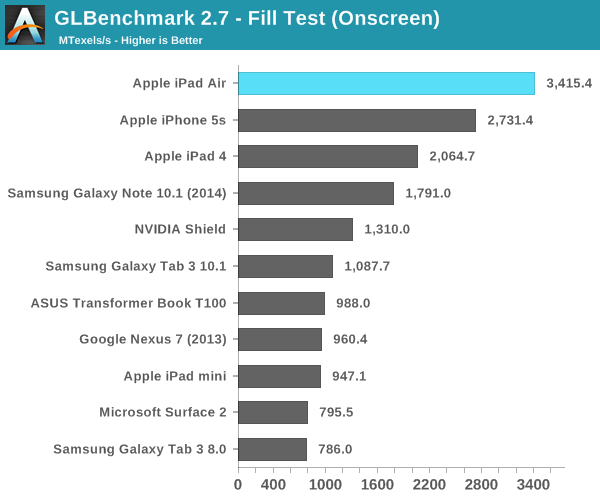
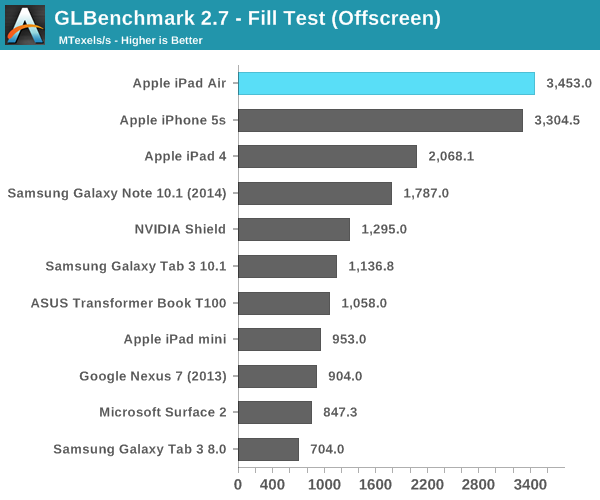
Looking at the fill rate results, there's a 4.5% increase in performance compared to the iPhone 5s. That could be the magnitude of clock increase that we're seeing between A7s. Apple could very well be relying on more thermal headroom in the iPad Air to provide any real world GPU performance advantages over the iPhone 5s.
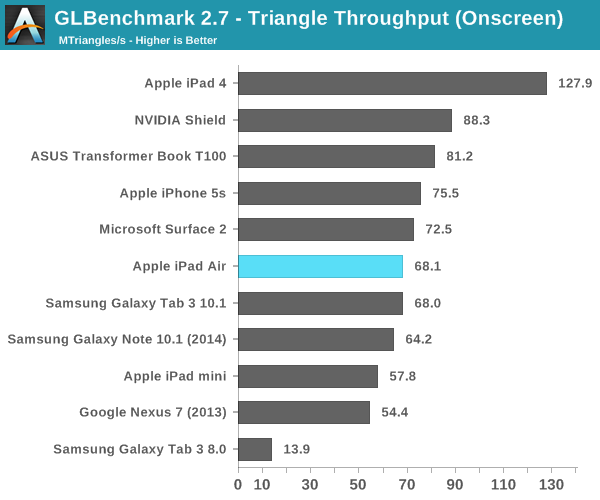

We see an even smaller gap between the Air and 5s in the triangle throughput tests (2.9%). There doesn't seem to be any substantial difference in GPU frequency between A7 implementations here. The regression in triangle rate performance compared to the iPad 4 is explained by differences in how Series 6 and Series 5XT GPUs scale in width. Whereas 5XT replicated nearly the entire GPU for "multi-core" versions, multi-cluster versions of Rogue only replicate at the shader array. The result? We don't see the same sort of peak triangle setup scaling we did back on multi-core 5XT parts. I'm not sure I'm particularly happy with the magnitude of the regression here, but I haven't seen any real world cases where it matters yet.
Next up are the game simulation tests. We'll start with the more strenuous of the two: T-Rex HD.
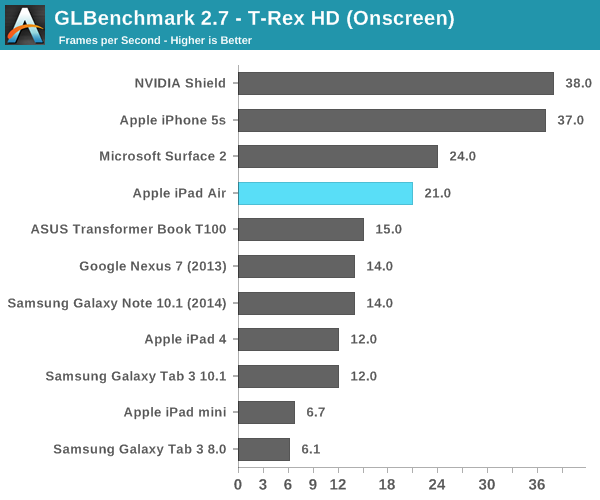
Here we get closer to Apple's claims of a 2x increase in performance. The iPad Air delivers 75% more performance than the iPad 4 in this test. Once again the iPhone 5s pulls ahead but that's because the onscreen tests render at display resolution, which is lower on the 5s.
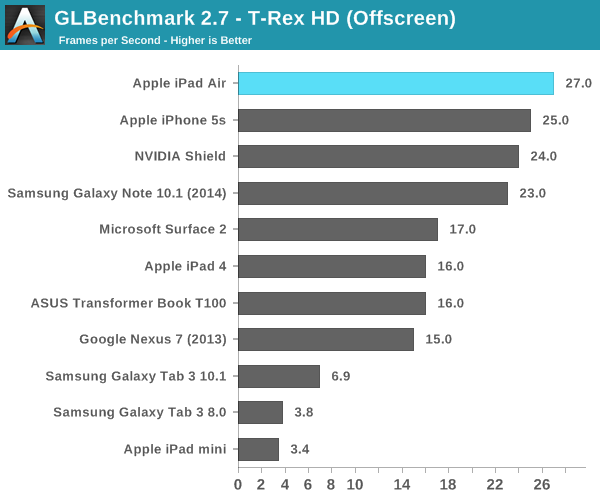
Offscreen performance sees similar scaling: ~69% better performance compared to the iPad 4.
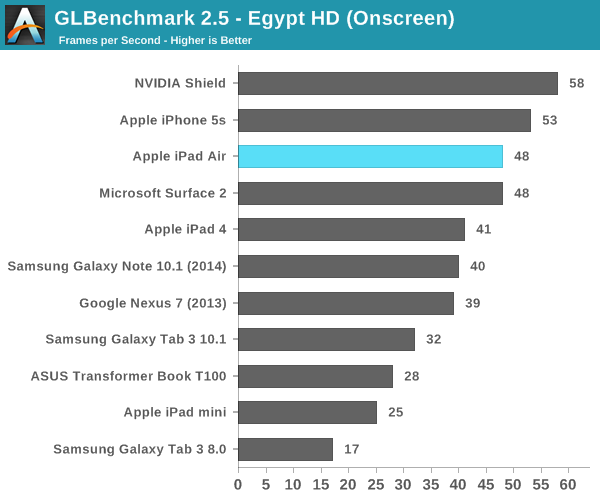
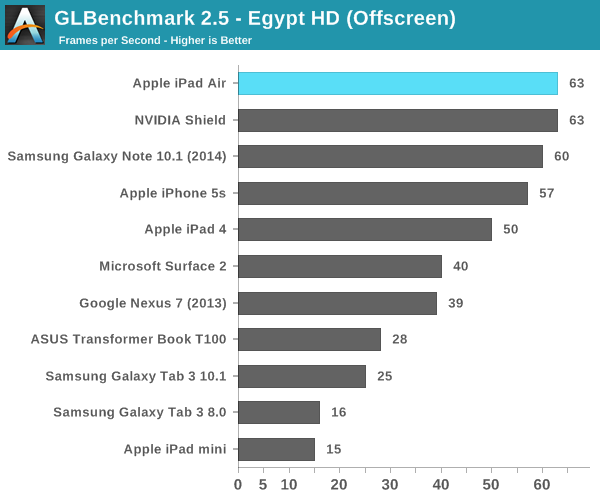
3DMark
We're once again running 3DMark's newest Unlimited mode which does its best to run independently of v-sync and at a standard resolution across all devices. I've also included 3DMark Extreme results below that feature a few more comparison points.
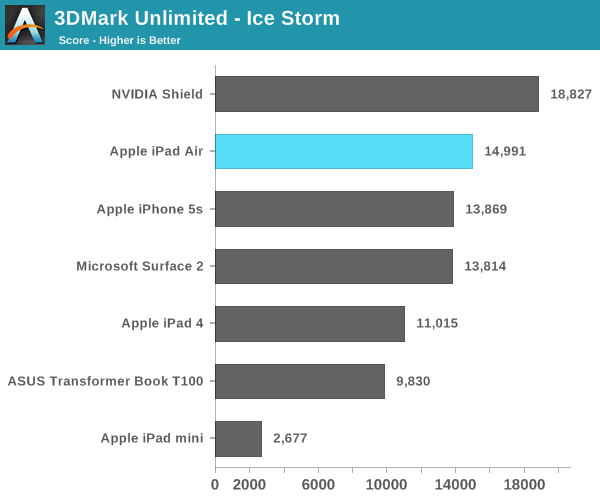
The overall Ice Storm scores show a 36% improvement in performance over the iPad 4 and an 8% increase compared to the iPhone 5s. Given the CPU frequency advantage of the A7 in the Air vs. the iPhone 5s, I'm guessing that's why we're seeing the performance gap we are here.
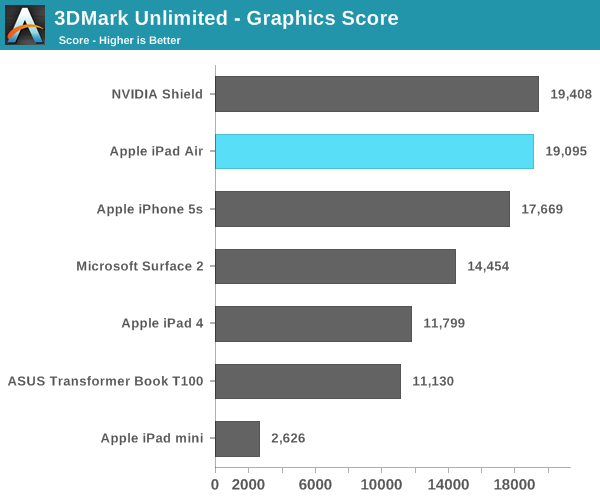
If we focus exclusively on the GPU tests (which themselves are still CPU bound), the iPad Air's performance advantage over the iPad 4 grows to over 60%.
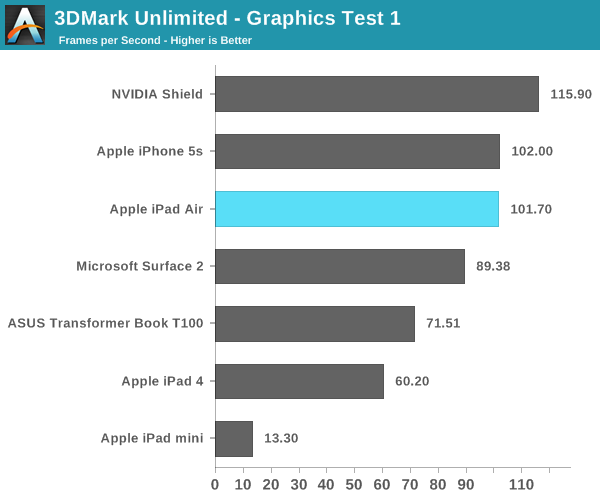
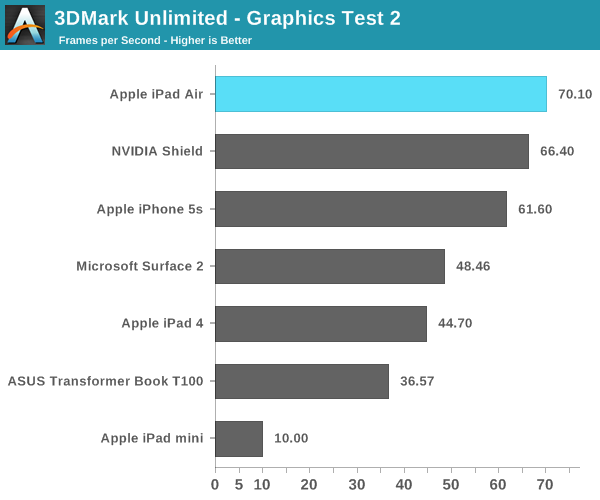
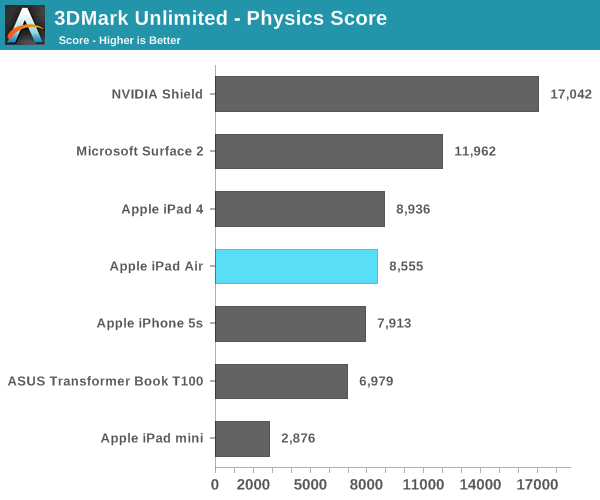
I'm still not entirely sure what's going on with the 3DMark Physics test, but we've seen this two reviews in a row now where Cyclone showed no performance increase at all compared to Swift despite this being largely a CPU test.
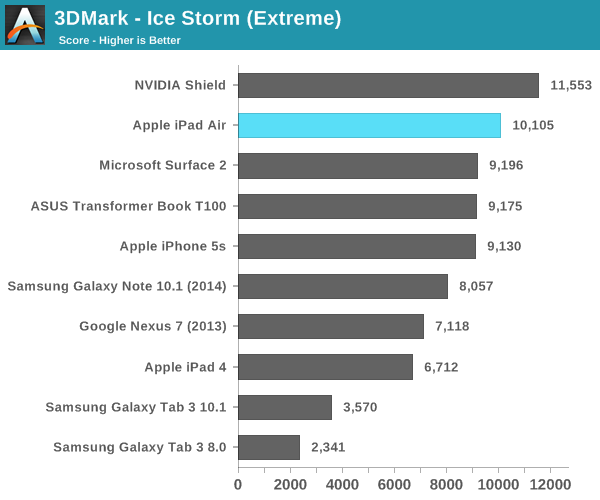
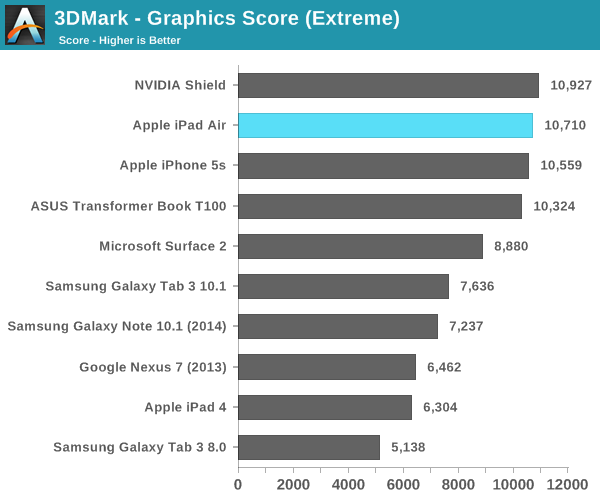
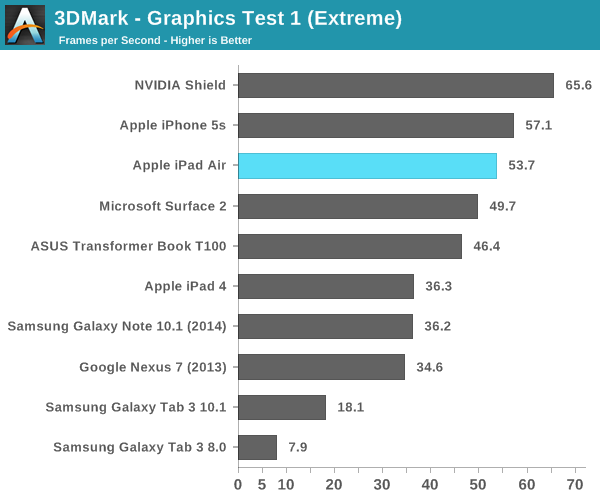
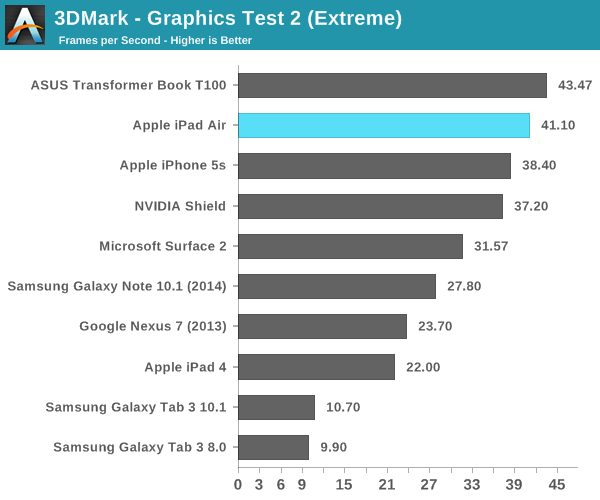

Basemark X
Basemark X is a new addition to our mobile GPU benchmark suite. There are no low level tests here, just some game simulation tests run at both onscreen (device resolution) and offscreen (1080p, no vsync) settings. The scene complexity is far closer to GLBenchmark 2.7 than the new 3DMark Ice Storm benchmark, so frame rates are pretty low.
I'm still having random issues with Basemark X reliably running both on and offscreen tests on iOS 7. Unfortunately I could only get onscreen results for the iPad Air, which came in at 46% faster than the iPad 4. Note the iPad mini and iPhone 5s benefit from having lower native resolutions here, which is why they perform so well.
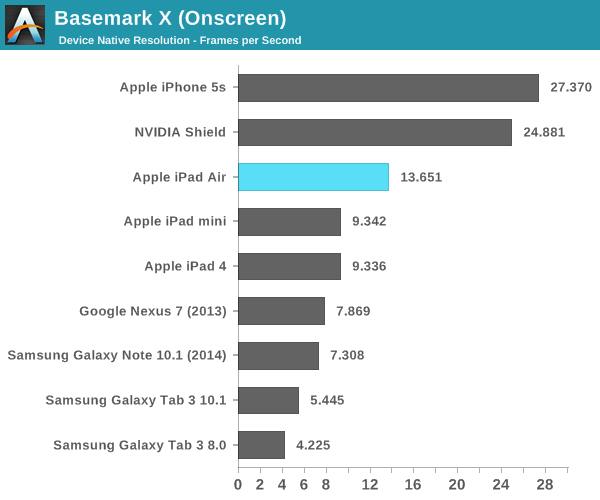










444 Comments
View All Comments
michal1980 - Wednesday, October 30, 2013 - link
Did you read? I was talking about windows 8.1, you know the big upgrade given away 2 weeks agoI know that in iSheep land windows doesn't exist.
abazigal - Saturday, November 2, 2013 - link
He's probably writing it even as we speak, and it will likely be posted in a matter a time.Anand has a ton of devices to review, so they have to set a priority. Not to mention that he has pretty much stated that he works on an iMac, so I imagine using Win8 actually takes away from his productivity time.
algalli - Wednesday, October 30, 2013 - link
Your right Windows 8.1 will be used by tens of people not hundreds of millions of people, at least in the tablet worldjecastejon - Wednesday, October 30, 2013 - link
And by the same standard, objectiveness and evidences you present I say you are paid by Apples's competitors.darwiniandude - Wednesday, October 30, 2013 - link
Really?? Strange... The detailed review I just read complained (politely) about Apple not letting them dissect (cut open) review (loan) units. It also mentioned GUI performance frame rate drops in the multitasking UI and complained that due to 64bit they really need to ship with 2GB ram rather than the 1GB they come with. I can guarantee most other reviews out there will not mention these particular technical negatives. Anandtech reviews are thorough.Rickschwar - Thursday, October 31, 2013 - link
Although I haven't seen too much Apple bias from AnandTech in the past, this is one of the most biased reviews I have ever read. This is surprising because normally AnandTech is the “gold standard” for all things technical. The reviewer talks about the iPad Air like it’s a revolutionary product, when there is little new about it. Apple was playing catch up in many ways and other tablets have many advantages over it. For example, the iPad 4 was thicker than many Android tablets. In fact, at least ten Android tablets were thinner than the iPad 4. The Air is only 1.9 mm thinner than the iPad 4 and tablets like the older Sony Experia Z are still significantly thinner than the iPad Air is (7.5mm vs. 6.9mm). Of course this wasn't mentioned in the article. Even when it comes to weight, the iPad Air isn’t dramatically lighter than the Experia Z (469g vs. 495g). That’s not mentioned in the article either.Since I’m in the market for a new tablet and I’ve owned two iPads in the past, I was hoping for big things with the new iPad, but for me and others it was a “meh” release. The same old display, the same A7 processor, and little real innovation. CNET agrees saying “Functionally, the iPad Air is nearly identical to last year’s model, offering only faster performance and better video chatting.”
The most ironic part for my is the fact than more 90% of this article is based on benchmarks -- even though AnandTech has made it clear how easy it is to game benchmarks and others (including an article I wrote over a year ago published at Mostly-tech.com) have made compelling cases that benchmarks do not predict real world performance. This article mostly ignores real world performance and pretends that Android tablets don’t exist.
After this article I will never look at AnandTech the same again. At least the CNET and Engadget reviews covered some of the limitations of this product.
- Rick
abazigal - Saturday, November 2, 2013 - link
The ironic thing about your statement is that for the moment at least, only Android OEMs have been found guilty of gaming benchmarks, not Apple. So doing any benchmark tests at this juncture would actually favour Apple's competitors, despite this being a review of an Apple product. So I don't see what reason you have to complain, when the odds are stacked in Android's favour anyways.Besides, Anand has thoroughly dissected the A7 chip in his 5s review, and concluded that it is actually faster and more power-efficient compared to the higher-clocked, quad-core processors found in Android phones and tablets. The fact remains that Android and most mobile apps generally aren't optimised with 4-cores in mind either. So for all intents and purposes, Android tablets may as well not exist, since they will likely lose to the iPad in terms of real-world performance anyways.
Also, the thing with these products is that they are ultimately a package deal. People don't just look at 1 single defining factor and buy a device based solely on that. Likewise, I am definitely not going to blindly buy the thinnest tablet in the market without first considering other factors like specs and availability of apps. You are not going to find that mythical Android tablet which is thinner, lighter, has a longer battery life, better screen, while boasting a larger market of apps and content.
I am sorry, but you are not going to find a more objective and detailed review anywhere else. You want the iPad air to be bashed, go hand out at some pro-android forum instead.
ADGrant - Saturday, November 2, 2013 - link
"Same old A7 processor". You look like a complete idiot when you post something like that. The A7 was announced less than a month ago.sunflowerfly - Thursday, October 31, 2013 - link
Anand biased? I do not believe that. They have no trouble pointing out Apple's flaws, and every product has them, nothing is perfect. The best products should win, and right now that happens to be Apple a lot of the time.ssiu - Tuesday, October 29, 2013 - link
No 2GB RAM; hope dashed :(Does that mean an iPad 4 (which can only run 32-bit code) will end up "less RAM starved" than iPad Air running 64-bit code?